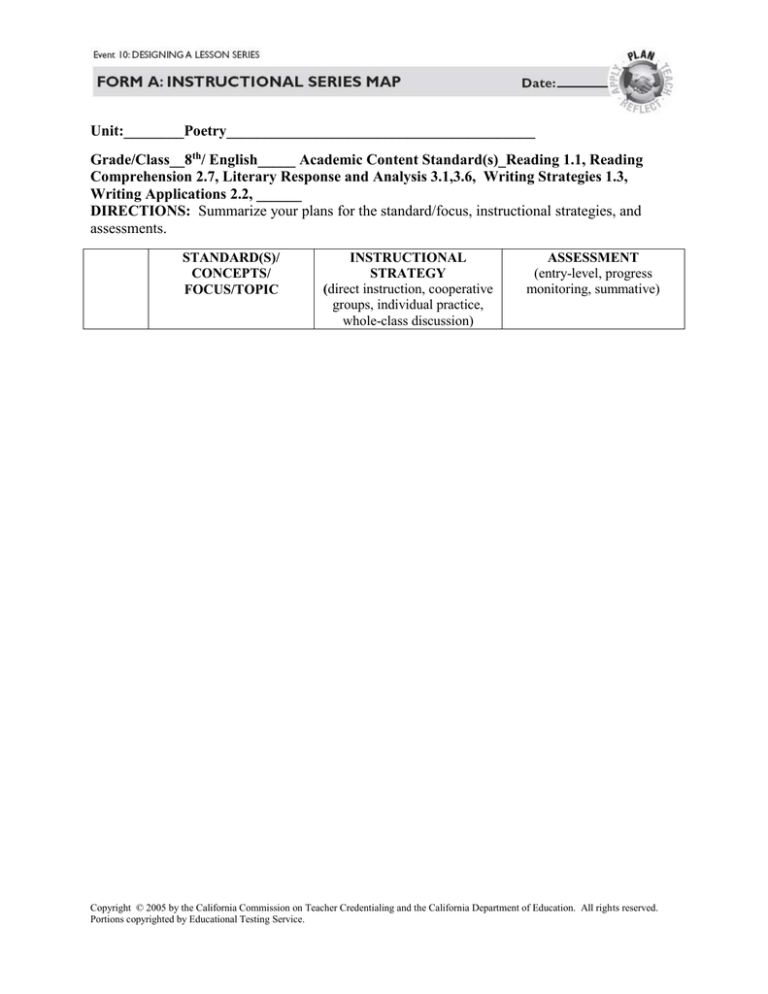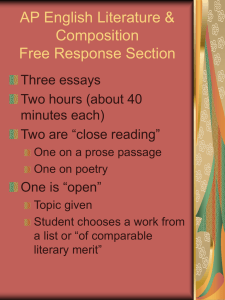
Unit:________Poetry_________________________________________
Grade/Class__8th/ English_____ Academic Content Standard(s)_Reading 1.1, Reading
Comprehension 2.7, Literary Response and Analysis 3.1,3.6, Writing Strategies 1.3,
Writing Applications 2.2, ______
DIRECTIONS: Summarize your plans for the standard/focus, instructional strategies, and
assessments.
STANDARD(S)/
CONCEPTS/
FOCUS/TOPIC
INSTRUCTIONAL
STRATEGY
(direct instruction, cooperative
groups, individual practice,
whole-class discussion)
ASSESSMENT
(entry-level, progress
monitoring, summative)
Copyright © 2005 by the California Commission on Teacher Credentialing and the California Department of Education. All rights reserved.
Portions copyrighted by Educational Testing Service.
Different styles and
forms of poetry (reading,
explicating, analyzing,
writing their own,
making a discussion blog)
Direct Instruction
Classwork
Whole-Class Discussion
Homework
Group Work (poetry
explications, literary terms
handouts)
Literary Responses
Individual Poems
Blog posts
LESSON PLAN
Individual Practice (literary
responses, poetry
explications, writing their
own poems, blog posts)
Literary Terms Quiz
Copyright © 2005 by the California Commission on Teacher Credentialing and the California Department of Education. All rights reserved.
Portions copyrighted by Educational Testing Service.
DIRECTIONS: Identify the critical understandings and skills for the selected content
standard(s) which you would expect students to have prior to the lesson series you are planning.
Identify prior experiences students may have had with the standard(s).
What prerequisite skills, concepts and knowledge will students need in order to meet the
standard(s)? Information sources include classroom assessment, district assessment, and CAT6
(grades 3,7,10), STAR (grades 2-11), and CELDT.
Class:
Students should have basic reading comprehension skills, basic analysis skills, note taking
skills, working cooperatively with others, basic computer skills, and reading skills.
English learners:
Students should have the same skills as above, except the reading and reading
comprehension skills can be on a lower academic level.
MODIFICATIONS/ACCOMODATIONS:
English Language Learner:
Students would be given extra poetry handouts to work on analysis and poetry explication
skills, also the poem would start out on an easier level in order to make the students feel
more comfortable with the process. Also the students would receive extra vocabulary
handouts to make them more familiar with poetry terminology.
Special Education Student:
Same as above.
Resources you might use:
Academic Content Standards/Framework
Teacher Resources – teacher’s guides, other instructional/support materials including Specially Designed Academic
Instruction in English (SDAIE) materials.
Student Resources – student texts, charts, rubrics, activity cards, exemplars, technology applications
District Curriculum Guides/ Course of Study
Observations and discussions with colleagues with subject-matter expertise and//or SDAIE experience and expertise
Copyright © 2005 by the California Commission on Teacher Credentialing and the California Department of Education. All rights reserved.
Portions copyrighted by Educational Testing Service.
DIRECTIONS: Complete one instructional plan for each lesson on Form A. If you use a
district lesson plan, copy and attach.
INSTRUCTION PLAN
K-12 Academic Content Standard(s):
REFLECTION
MODIFICATIONS/ACCOMODATIONS:
English Language Learner:
Same.
What is the academic learning goal(s)?
Students are able to identity and define
different literary terms.
Students are able to critically analyze a
poetry piece.
Students are able to write their own
individual poem.
Special Education Student:
Students are able to use an internet blog and Same.
make academically appropriate posts.
Students are able to write an academic
literary response to a poem.
Copyright © 2005 by the California Commission on Teacher Credentialing and the California Department of Education. All rights reserved.
Portions copyrighted by Educational Testing Service.
Copyright © 2005 by the California Commission on Teacher Credentialing and the California Department of Education. All rights reserved.
Portions copyrighted by Educational Testing Service.
INSTRUCTION PLAN
What instructional strategies and activities
will you use for this lesson?
REFLECTION
In what ways are your instructional strategies
and activities effective in measuring the
learning goals for this lesson?
Class:
Students would have a variety of activities
and a lot of opportunities to practice the
new skills presented. They would have
whole-class poetry explications/analysis,
group work in the same field, and finally
individual practice. Students would do
handouts on poetry terms, literary
responses, write their own poems, and do
blog posts. Students would get constant
feedback, because that is important to
ensure academic progress and feeling at
ease with poetry.
English Language Learner modifications:
Students would receive extra handouts on
terms and poems, because that would give
them more practice. They would also have
the option of group meetings with the
teacher in order to work on their skills
outside of the class environment (tutoring
sessions).
Class:
Students would show their knowledge of the
skills orally and in written format. They
would have multiple outlets for practice and
they would always be turning in work, so
the teacher could monitor their progress.
English Language Learner:
Same as above plus the extra work would
also be evaluated by the teacher during the
tutoring sessions.
Special Education Student:
Same as English Language Learner.
Special Education Student modifications:
Same as above.
Copyright © 2005 by the California Commission on Teacher Credentialing and the California Department of Education. All rights reserved.
Portions copyrighted by Educational Testing Service.
INSTRUCTIONAL PLAN
PROGRESS MONITORING ASSESSMENT
What evidence (student work) will you collect
during this lesson that will show the extent to
which students have achieved the learning
goal(s)?
REFLECTION
In what ways are your assessment strategies
effective in measuring the learning goals for
this lesson?
Class:
Group poetry explications/analysis,
individual literary responses, individual
poetry explications, poetry terms quiz,
individual poems, poetry handouts, and
checking the blog posts.
Class:
The explications show their abilities to
critically analyze poetry, the quiz shows the
knowledge of the terms, the blog posts show
their knowledge to express their thoughts
while making connections to the text, and
their own individual poems show their
mastery of skills. (to make your own poem
means you have to understand the form and
the literary terms)
English Language Learner modifications:
All the work above and their extra terms
and poetry worksheets.
English Language Learner:
The extra worksheets would make them feel
more comfortable with poetry and give
them a chance to enlarge their vocabulary.
Special Education Student modifications:
Same as English Language Learners.
Special Education Student:
Same.
How might you modify assessment of the
academic content standard(s)?
Class:
Content standards are included in all the
activities.
English Language Learner:
Special Education Student:
Copyright © 2005 by the California Commission on Teacher Credentialing and the California Department of Education. All rights reserved.
Portions copyrighted by Educational Testing Service.
INSTRUCTIONAL PLAN
How will you group students for instruction
during this lesson? (based on reading level,
English learner level, etc.)?
Groups would be made at random.
How did you choose the group for English
Language Learner?
They would be grouped with other English
Language Learners or be spread out with
students from the rest of the class, but
always have another English Language
Leaner with them.
How did you choose the group for Special
Education Student?
They would be with other Special Education
Students, or English Language Learners, or
with patient high achieving regular
students.
REFLECTION
In what ways are these grouping(s) appropriate
for your students?
Class:
This would give the students the
opportunity to work with various academic
level students and heighten their
cooperation skills.
English Language Learner:
This would create a comfortable
environment, while challenging them
academically at the same time. Also not
singling them out too much, which is why
spreading them out is a good idea.
Special Education Student:
Same as above.
In what ways are the materials and technology
effective?
What instructional materials and technology
will you use?
Textbook, handouts, computer, paper, and
pens.
English Language Learner modifications:
Same.
Special Education Student modifications:
Same.
Class:
Easily accessible, because everything can be
found in the classroom. Even if they do not
have computers at home they students can
come in during free school time to do their
post (of if they have an extra few minutes
during class).
English Language Learner:
Same.
Special Education Student:
Same.
Copyright © 2005 by the California Commission on Teacher Credentialing and the California Department of Education. All rights reserved.
Portions copyrighted by Educational Testing Service.







